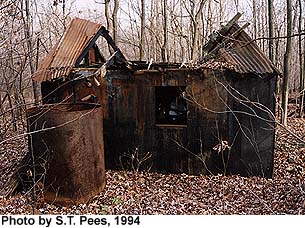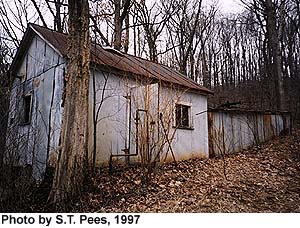|
|
Profile of a Power
 |
What profile? This is one of those dark patches in the brush. The power is nearly concealed by the hawthorn, other brush and vines. There are plenty of rod lines in the picture. You can see two eccentrics, clamps, belt and belt pulley and the big gear. Wooden planks from the old building have fallen into the jumble. This Simplex power is in the old Shamburg field, on the plateau bordering Oil Creek on the east. The wells it pumped are still there.
|
Its a thrilling experience to sight an old abandoned power in the oilscape. Some are housed in corrugated metal buildings, welded and stalwart in their day, but now rusting away. Others are in wooden sheds which have caved in, the roof left draping awkwardly over the machinery. It's hard to describe a profile. A few operated entirely without protection from the weather, but they must have been difficult to work in the snow months. The remains of a pumper's shack is often found nearby, but sometimes the power was the bunkhouse too.
The engine sits inside on a foundation near the entrance. It runs the power at the other end of the building via a belt. The power is also mounted on a foundation. Most powers had a belt tightener, placed about midway between the engine and the power pulley. Shelves and a workbench are commonly found in the building. Many of the old powers still have tools and fittingslying around. The rusted remains of an old stove is a common sight. So are bed springs and a dented coffee pot.
One engineer with the famous Brundred Oil Corp. of Oil City, Pa., described the old wooden powers as roughly resembling a square dumbbell (Brown, 1937). Some of them, still standing (more or less) in the woods, do (or did) have this appearance. That shape is probably as near to a typical profile as you can get. A 12' x 12' x 8' room housed the engine, it opened into the long and low belt runway (45' x 6' x 5') which joined with the power room which was 12' x 12' x 10'. Can you picture these two humps with the long, low "handle" holding them together? This power would be 69 feet (21 m) long. Most of them are shorter. Trouble is, parts of the old power buildings have collapsed, totally modifying the original profile. The dumbbell has become a figure of speech rather than an actuality.
In some instances, electric motors (15 H.P.) allowed a decrease in the size of a power building. The long belt house was no longer necessary because a short, coupled, chain drive was all that was needed. However, some installations simply had the electric motor placed on the old engine and the motor drove the belt. In those cases the original building arrangement continued to serve. Electric motors became common in new powers in the mid-1930's. A lot of those powers are abandoned now. The electrical hookup, even the motor, are still there in some.
Nature has provided many disguises for the old, abandoned powers. Some are densely grown over. A dark place in the woods or brush may hold a power. Sadly, there are a lot of foundations out there too. The powers they once supported have been dragged out of the forest to the dirt road and then hauled off to another lease or, as is often the case, for scrap. The monuments that are left intact are precious keepsakes, even if falling down.
 |
This hump is an old model Reid power. The building has settled around it and hunters found it to be a vantage point for hunting turkey, deer or bear. The author is sitting on a chair placed there by a hunter who also draped part of a torn orange camouflage suit on a fallen rafter. Turkey tracks were everywhere.
|
|
|
|
 |
A power starting to go. The hump on the left has begun to collapse, modifying the dumbbell shape. This is the view that the hiker sees when the power looms up in the woods. It's an exciting moment and one hurries to look in.
|
|
|
 |
A stubby engine house of a Reid power. Engines of that era were water cooled which probably explains the tank.
|
|
|
 |
This profile is common. The eccentric of the power is at the far end of the corrugated metal beltway and is partly obscured. The engine (now gone) was in the front building. This power was built to fit the contour of the landscape. Wells are nearby and the jacks can be pumped by pulling on the rod lines.
|
|
|
 |
Part of a power on the bank of the Allegheny River. Red was a favorite color of some operators.
|
|
|
 |
This is an old power that was run by an electric motor in its last days. The motor replaced the natural gas engine, most of which was kept in place to serve as a motor mount after the cylinder etc. were removed. You can see that the original engine installation was in a building of which some foundation is left. Pieces of metal roof are scattered here and there. The belt runway is in place and a Simplex power sits on its foundation to the left of the end of the covered runway. The belt pulley (not visible) is on the right of the Simplex power, sticking into the runway. A wood three-pole and a metal tripod are visible at the edge of the woods. More are faintly seen deeper in the woods. They supported the rod lines.
|
|
|


![]()





